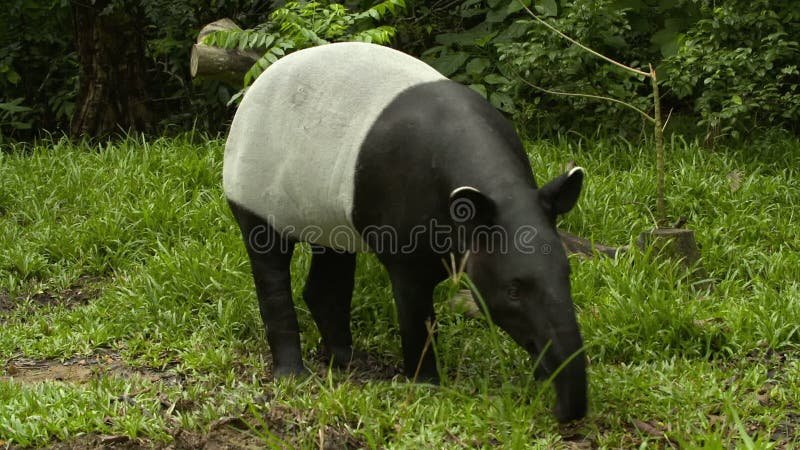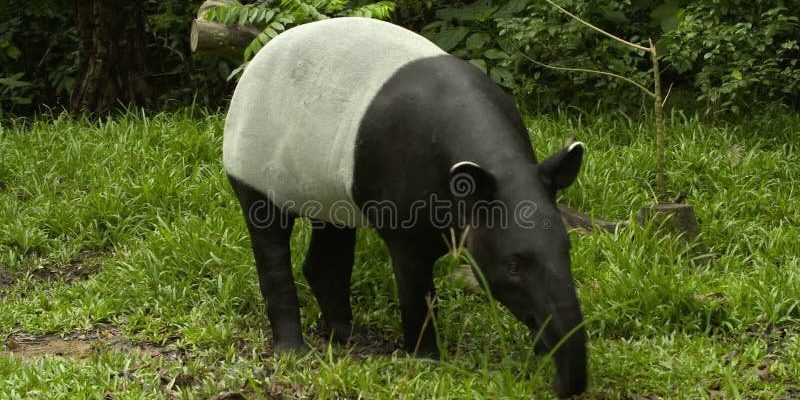
Imagine wandering through a lush rainforest, where the sunlight barely breaks through the thick canopy above. Among the shadows, the Malayan tapir roams, quietly foraging for food. Unlike many other animals, it doesn’t chase down prey but instead relies on its ability to consume a wide variety of plants. Think of it as the ultimate forest gardener, picking just the right leaves, fruits, and flowers without causing too much disruption. If you’ve ever wondered how different animals adapt their eating habits to survive in the wild, this deep dive into the Malayan tapir’s diet and strategies is for you.
Understanding the Malayan Tapir’s Diet
The Malayan tapir is a herbivore, which means it thrives on a plant-based diet. Its food choices are diverse, allowing it to adapt to different environments. In the wild, you can find these gentle giants munching on a range of vegetation, which helps support their unique lifestyle. The tapir primarily eats leaves, fruits, and shrubs, but it also enjoys aquatic plants when available. Their long snouts make it easy to reach branches and foliage that other animals may struggle to access.
Leaves are a significant part of the Malayan tapir’s diet. These herbivores are particularly keen on young, tender leaves that are more nutritious. They often browse through dense foliage, using their strong jaws to tear off pieces. You might see them bending low or even standing on their hind legs to grab a tasty treat high up.
Fruits are another favored food item. The tapir has a sweet tooth for various fruits, especially those that fall from trees. They play a crucial role in seed dispersal, helping trees propagate and thrive. When a tapir eats a fruit, it can carry the seeds through its digestive system and deposit them far away, contributing positively to the ecosystem.
Lastly, aquatic plants make up part of their diet, especially in areas where water is abundant. Tapirs are excellent swimmers, and their adaptability allows them to dive into water to reach plant life submerged beneath the surface. They’re like the original garden variety, combining the roles of eater and gardener in one.
Feeding Behavior and Habits
Malayan tapirs have specific feeding behaviors that help them stay nourished without overexerting themselves. They tend to be primarily nocturnal, which means they do most of their eating at night. This helps them avoid the heat of the day and many predators. Imagine the tapir as a nocturnal gardener, stealthily picking the best plants under the cover of darkness.
They use their snouts to forage for food, which is well adapted to their feeding habits. This long, flexible nose acts like a natural hand, allowing them to grasp and pull at leaves and branches. Unlike many animals that have to rush to eat, tapirs take their time, savoring each bite. They often remain in one spot for extended periods, carefully choosing what to eat next.
Tackling some common misconceptions, you might think that tapirs are very picky eaters. However, that’s not quite the case. They have a varied menu and can adapt to changing food availability. This flexibility is essential for their survival, especially in areas where different plant species might be affected by seasonal changes. In a world full of uncertainties, the Malayan tapir’s adaptability is a remarkable trait.
Hunting Strategies? More Like Foraging Tactics
Now, you might be wondering about hunting strategies—surely, the tapir must have some clever tricks up its sleeve, right? Well, here’s the thing: the Malayan tapir isn’t a hunter in the traditional sense. As a herbivore, it doesn’t hunt for prey but instead forages for food. Its “hunting tactics” revolve around finding and selecting the best plants.
These animals are incredibly skilled at navigating their environment. They have excellent senses of smell and hearing, which help them detect food and avoid potential dangers. The tapir sniffs out delicious fruits from a distance, following its nose like a bloodhound. When it comes to safety, they can freeze in place, blending into the surroundings—a tactic they’ve mastered over time.
Another unique aspect of their foraging is their role in the ecosystem. By eating and dispersing seeds, they help maintain plant populations in the forest. So, while they don’t hunt like predators, their contributions to their environment are just as significant. When you think about the Malayan tapir, you can see it’s not just about survival; it’s about maintaining a balance in nature.
The Role of Tapirs in Their Ecosystem
The Malayan tapir plays a vital role in its ecosystem, often acting as a seed disperser and influencer of the plant community. As they travel through their habitats, munching on various plants, they inadvertently aid in the growth and spread of different species. When a tapir digests fruit and then drops the seeds, it creates new opportunities for plants to grow in different areas.
This process is essential for the health of forests. Without animals like the tapir, many plant species might struggle to spread and reproduce. They are like tiny gardeners of the forest, nurturing the plants they eat. Additionally, their eating habits help maintain the balance of vegetation in their territory, ensuring no single species overgrows and takes over.
Furthermore, the presence of tapirs can attract other species. Their activities create open spaces and modify the landscape, allowing different plants and animals to thrive alongside them. When you think about it, tapirs contribute to a rich tapestry of life in their tropical forests, reinforcing the idea that every creature, no matter how odd it may seem, has a purpose.
Conservation Status and Threats
Despite their fascinating lifestyle, the Malayan tapir faces several threats that endanger its survival. Habitat loss due to deforestation is among the biggest challenges. As forests are cleared for agriculture and urban development, tapirs lose their natural homes and food sources. Imagine being forced to move every time your favorite snack joint closes down; that’s essentially what these animals face.
In addition to habitat loss, hunting poses a significant threat. Although hunting of tapirs is illegal in many areas, poaching still happens. Some people hunt them for their meat, while others chase them for their skin. This illegal activity puts an extra strain on their already declining populations.
Efforts to conserve the Malayan tapir are critical. Organizations worldwide are working to protect their habitats and raise awareness about the importance of preserving these unique creatures. Supporting conservation efforts can help ensure that future generations can appreciate the quirky and vital Malayan tapir. It’s like being part of a team that strives to keep the balance of nature intact.
The diet and “hunting” strategies of the Malayan tapir offer a unique glimpse into how one species navigates the complexities of its environment. Through its herbivorous lifestyle, it forages for food, contributes to seed dispersal, and helps maintain the health of tropical forests. While its sometimes odd appearance might make it blend into the background, its role in the ecosystem is anything but insignificant.
Understanding the challenges these gentle giants face in today’s world is essential. From habitat loss to illegal hunting, the Malayan tapir needs our support. By learning about their lifestyle and advocating for their conservation, we can help preserve their place in nature. So, the next time you think about this peculiar animal, remember it’s not just a tapir—it’s a key player in the delicate balance of our planet’s ecosystems.

